The Book Collecting Guide
A practical reference for understanding book condition, anatomy, and value.
Last updated: November 7, 2025 • Authors: Page & Provenance team
Educational reference only — not a valuation tool
Grading Scale (ABAA-aligned)
Essentially pristine with no defects whatsoever. For modern books, this means unread with sharp, square corners and a flawless dust jacket. The binding is tight, pages are crisp and clean, and there are no marks, stains, or signs of wear.
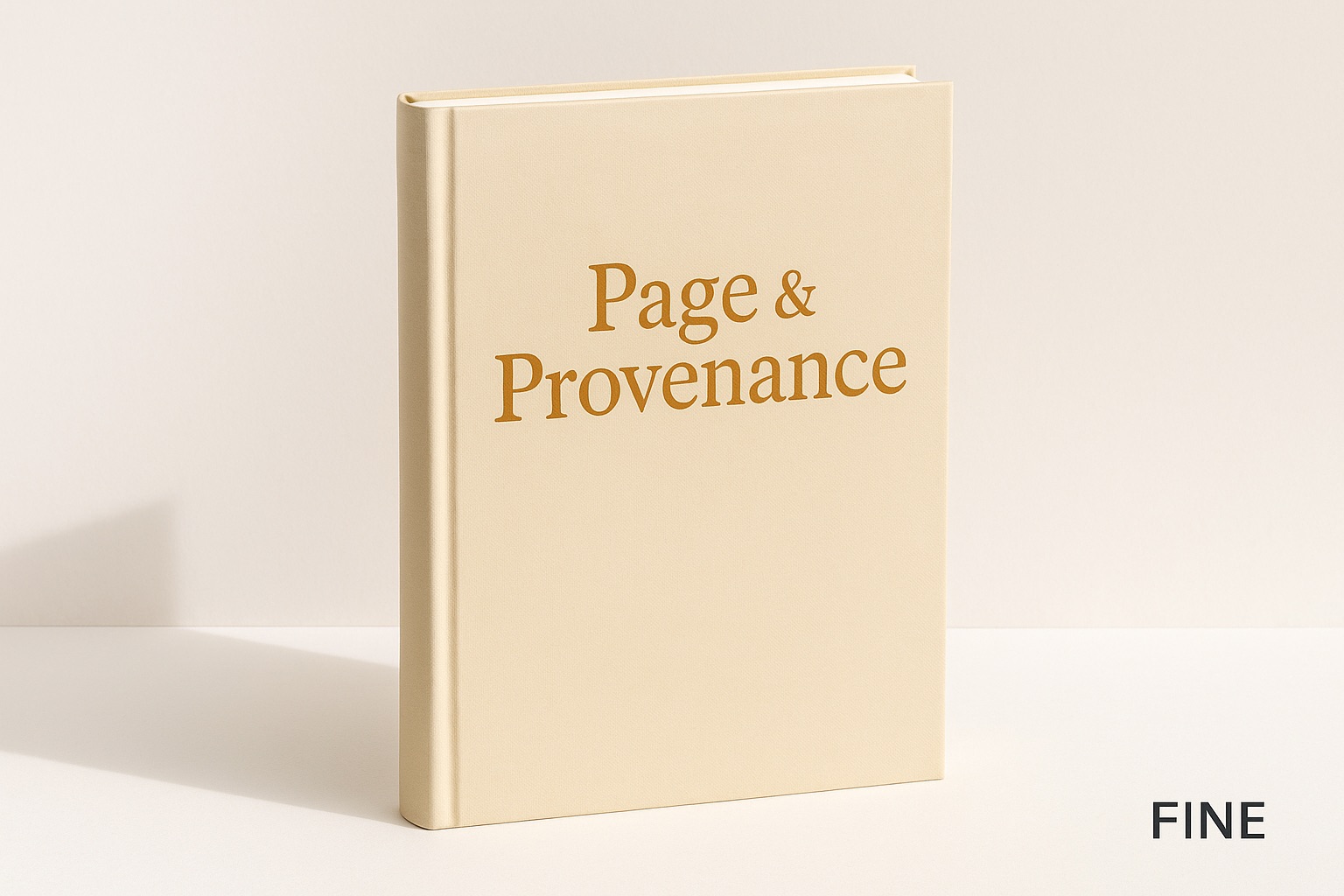
Shows minimal signs of careful handling. May have tiny rubs on the jacket edges or very faint toning to pages. The binding remains tight and clean with no major marks. Often indistinguishable from Fine to the untrained eye.
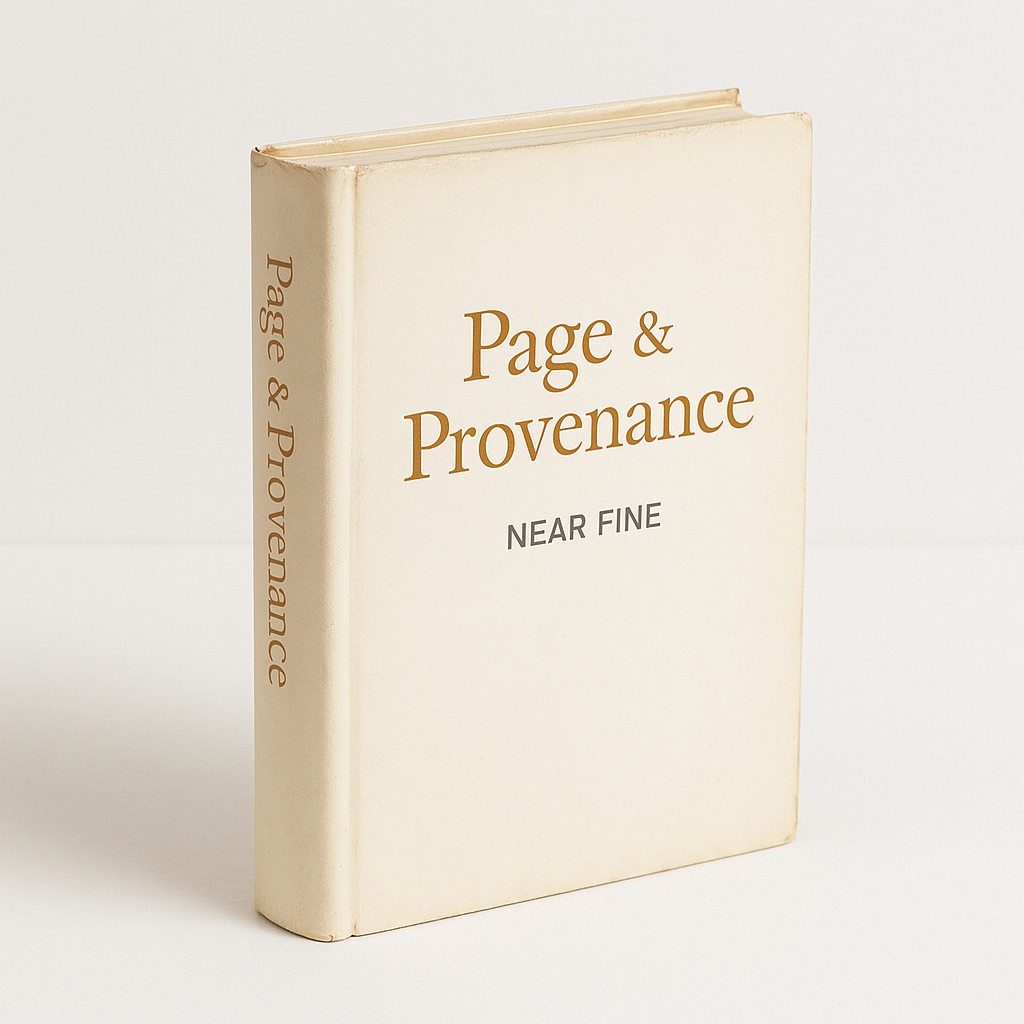
Clearly handled but complete and sound. May show small chips or tears to the dust jacket, light foxing or soiling to pages, and mild spine lean. Still an attractive copy that shows well on the shelf.
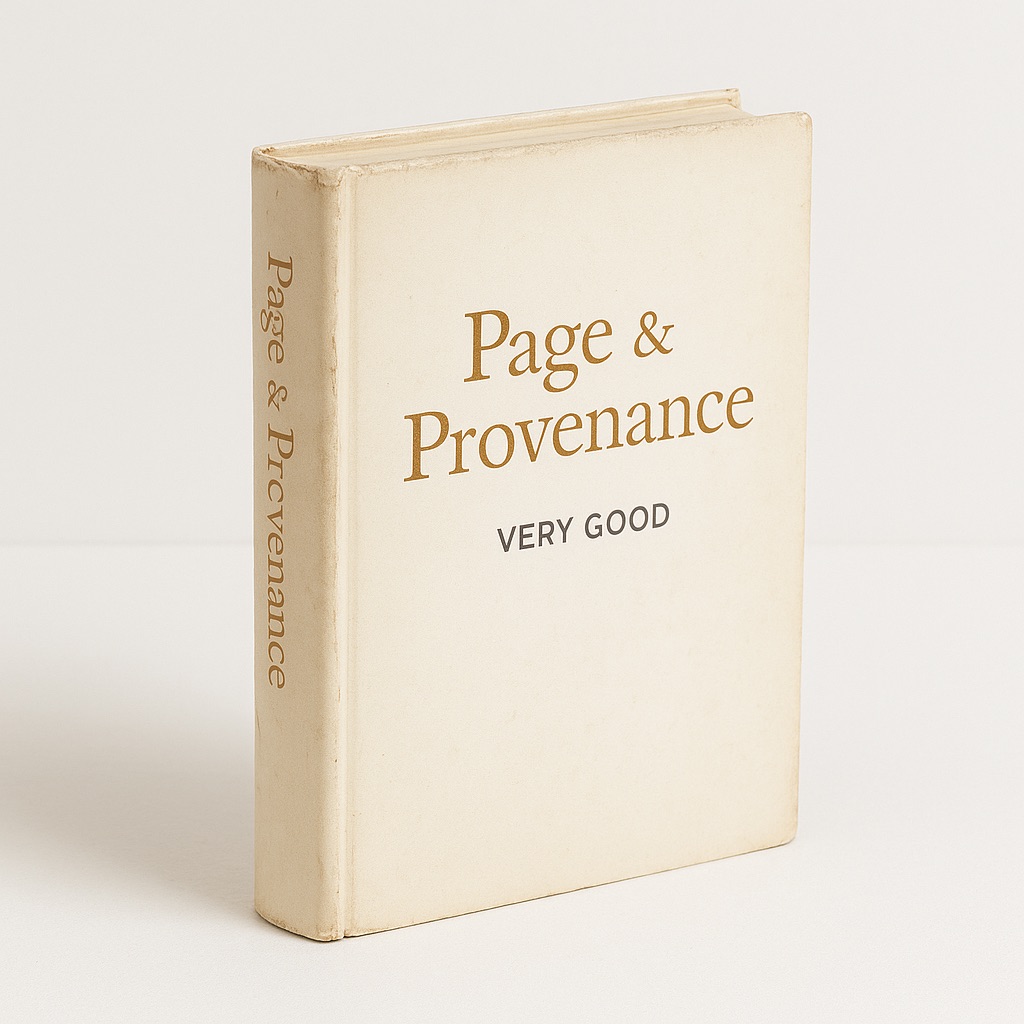
Average used copy with significant wear but still complete and readable. May have writing, tears, or repaired splits. Acceptable as a sound reading copy but not for high-grade collections.
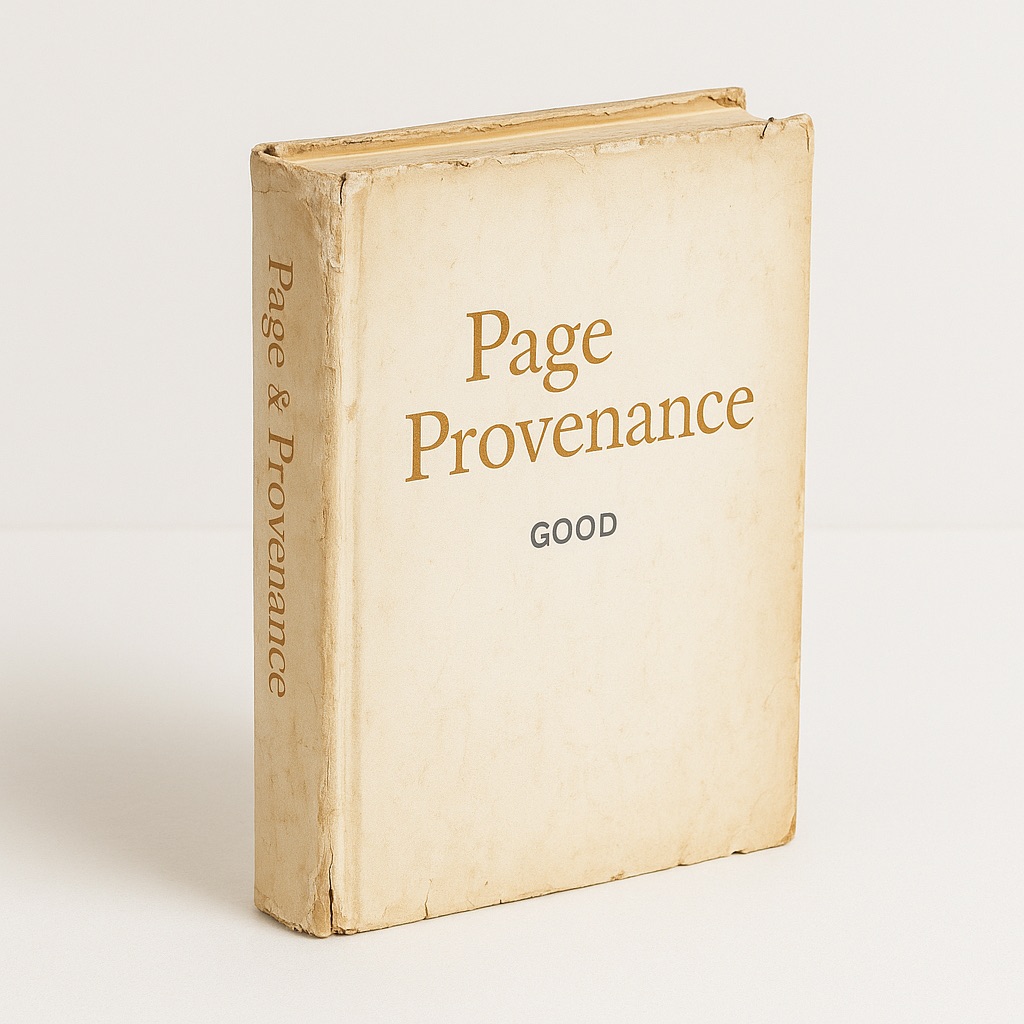
📚 Readable but heavily worn.
- • Complete text block — all pages present, though they may be loose or detached.
- • Covers and spine intact but with major wear, tears, staining, or fraying.
- • May have repairs, tape, or partial jacket loss, but still recognizable as the original book.
- • Binding is weak but holding or restorable.
- • Usually still considered collectible if the book is rare or historically significant.
🟠 Think: battered survivor.
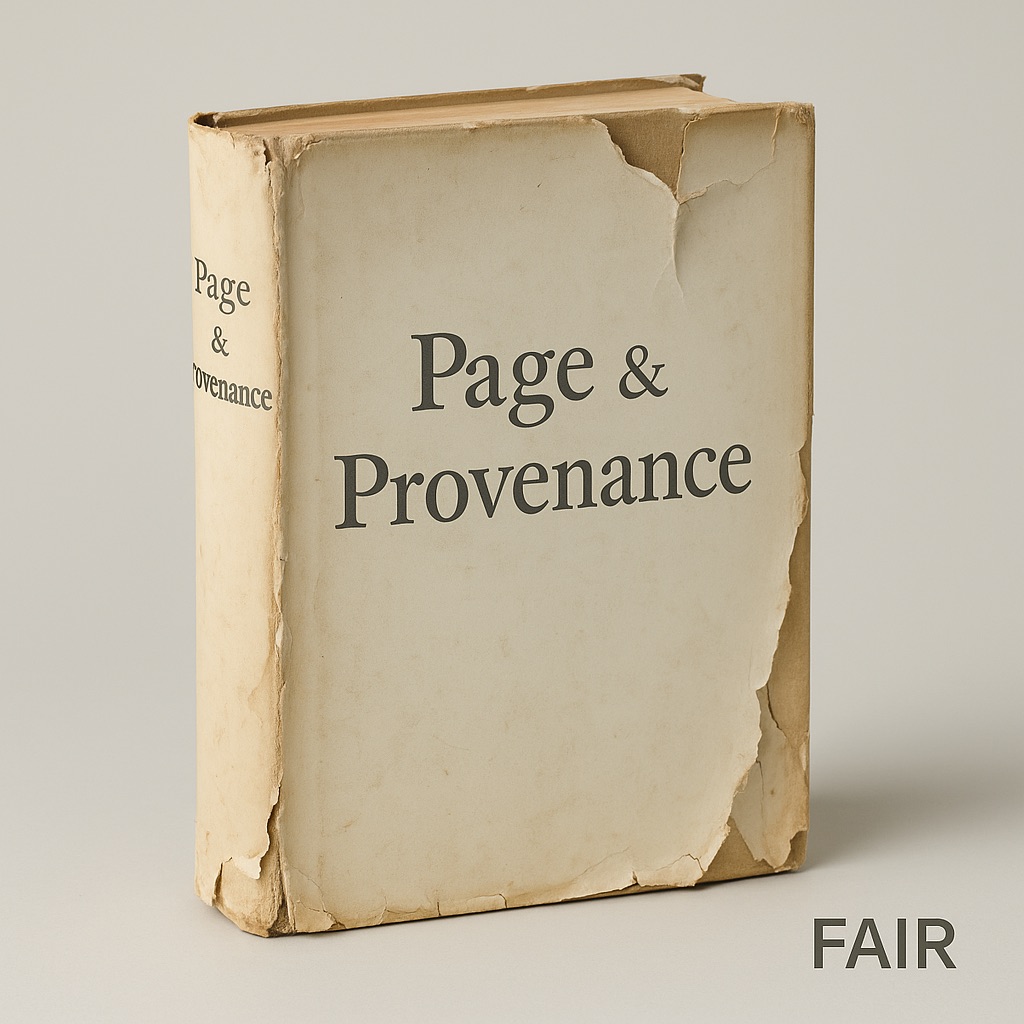
📕 Barely holding together, sometimes incomplete.
- • Pages or covers missing, detached, or severely damaged.
- • Text may be affected by stains, tears, burns, or missing portions.
- • Binding nonexistent or completely broken.
- • Dust jacket may be gone or in tatters.
- • Only retained for reading, restoration, or research value — not usually collectible except for extreme rarity.
🔴 Think: relic or placeholder copy.
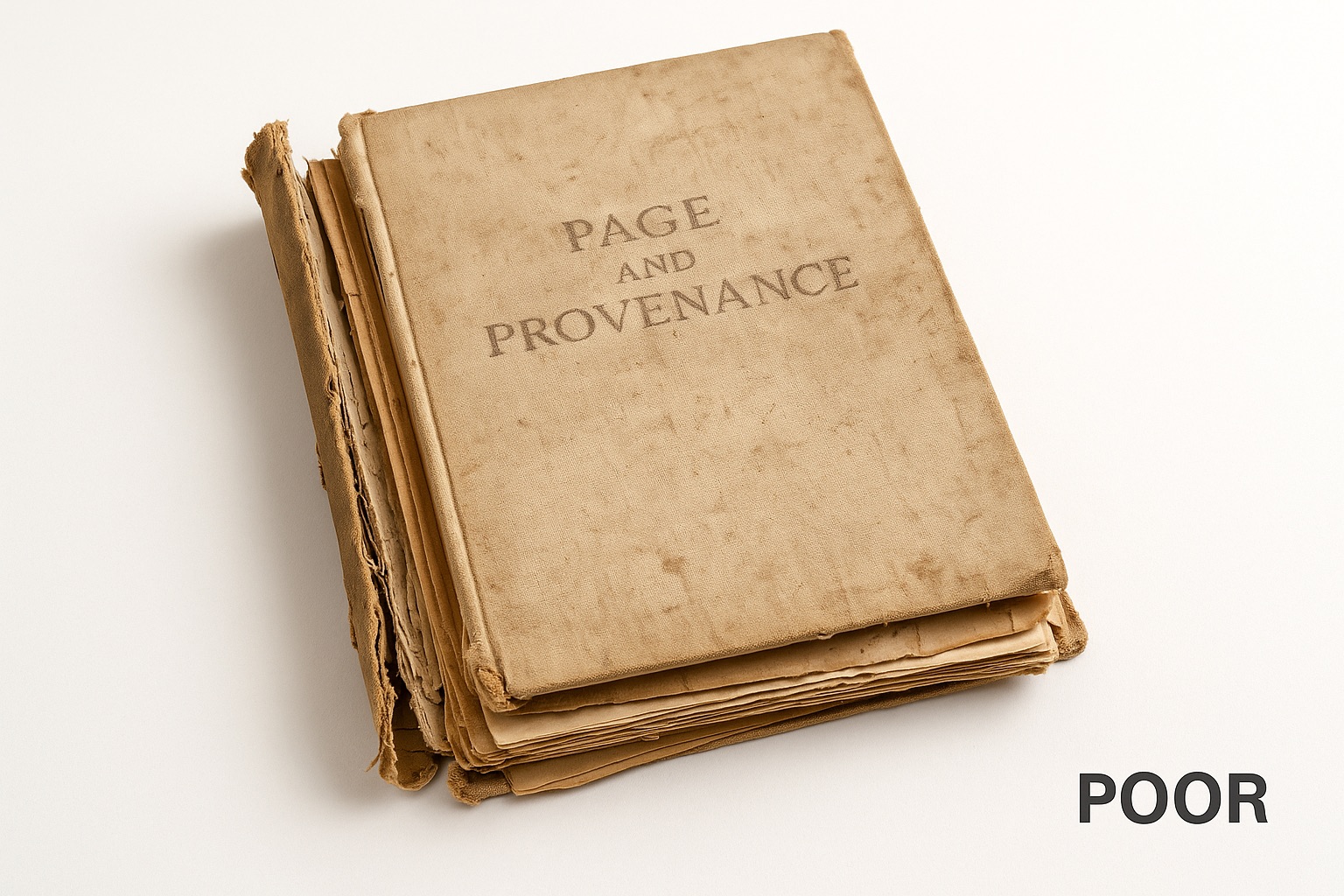
Book Anatomy
The title page displays the book's full title, author(s), and publisher information. The copyright page (verso of title page) contains critical identification data including the copyright date, printing information, and publisher's address.
What to Check:
- Verify author name, complete title, and publisher match known bibliographic data
- Check the number line (e.g., "1 3 5 7 9 10 8 6 4 2" indicates first printing)
- Look for explicit statements like "First Edition" or "First Printing"
- Match copyright year to title page year for potential first edition
- Note any edition statements, revision numbers, or reprint indicators
Photo placeholder: Title & copyright page example
/images/anatomy/title-copyright.jpg
The removable paper cover wrapped around the book's binding. For most modern collectible books, the presence and condition of the original dust jacket is crucial to value—often representing 60-90% of the book's worth.
Anatomy of a Dust Jacket
A dust jacket is a single printed sheet folded around a hardcover book. It has six main parts:
| Section | Location | Typical Contents |
|---|---|---|
| Front Panel | The main front-facing section of the jacket — the part you see first on display. | Book title, author name, main cover art or illustration. |
| Spine Panel | The narrow vertical section that wraps around the book's spine. | Title, author, publisher's logo — designed to be visible on a shelf. |
| Back Panel | The large section opposite the front panel, on the reverse side of the book. | Often contains reviews, summary blurbs, or a photo of the author. |
| Front Flap | The inner flap that folds inside the front cover. | Usually shows the retail price, description, or publisher summary. |
| Back Flap | The inner flap that folds inside the back cover. | Often lists other books by the author, or publisher ads. |
| Price Corner | A small printed price (e.g. "$2.95") usually on the top or bottom edge of the front flap. | The presence or absence of a price helps identify Book Club Editions or later printings. |
What to Check:
- Price: Is the original price present on the flap? Price-clipped jackets reduce value
- Chipping: Small losses at spine ends, corners, or along edges
- Tears: Length and location of any tears (closed tears are better than losses)
- Sunning: Fading on the spine from UV exposure—compare to front panel color
- Codes: Publisher codes on flaps can indicate printing (e.g., "8/87" = August 1987)
- Restoration: Look for tape repairs, color touch-ups, or replaced pieces
💡 Pro tip: Store dust jackets in archival Mylar sleeves—never tape repairs directly to the paper!
Photo placeholder: Dust jacket anatomy diagram
/images/anatomy/dust-jacket.jpg
Traditionally, the price corner refers to the upper or lower corner of the front flap of a dust jacket — never on the back flap or spine.
However, its exact placement varies by publisher and era:
| Era | Common Price Location | Notes |
|---|---|---|
| 1900s–1940s | Lower front flap corner (right or left) | Often small type, sometimes inside the fold. Some early British publishers used penciled or stamped prices. |
| 1950s–1970s | Upper right of the front flap | Became the norm for most US publishers (Knopf, Random House, Scribner's). Easy for bookstore display. |
| 1980s–present | Upper or lower right front flap | Still common, though some omit price entirely for export copies. |
| Book Club Editions | No printed price | Usually blank corner or "Book Club Edition" text instead. |
Key Takeaway:
Yes — the price corner can appear in different places depending on publisher and time period, but it's always on the front flap, not the back or spine.
The stiff front and back covers of a hardcover book, typically made of cardboard covered with cloth, paper, or leather. The boards protect the text block and provide structural integrity.
What to Check:
- Corner wear: Bumping or rubbing at the corners (very common)
- Edge wear: Fraying or rubbing along board edges
- Bowing or warping: Boards that no longer sit flat
- Staining: Water damage, sun exposure, or other discoloration
- Blind stamps: Impressed marks (common on book club editions)
- Gilt/lettering: Condition of gold or colored lettering on spine/boards
Photo placeholder: Board wear examples
/images/anatomy/boards.jpg
The backbone of the book that connects the front and back boards. Usually displays the title, author, and publisher. The spine is critical for shelf appeal and structural soundness.
What to Check:
- Lean (cocking): Book tilts when stood upright—indicates stress or poor storage
- Head/tail fraying: Wear at top and bottom of spine
- Sunning: Color fading from light exposure
- Creasing: Horizontal lines from improper opening
- Lettering condition: Fading, rubbing, or loss of gilt/stamping
- Rolling: Spine rounds outward (common with reading)
Photo placeholder: Spine conditions
/images/anatomy/spine.jpg
The hinges (inner joints where endpapers meet the text block) and joints (outer grooves where boards meet the spine) are critical stress points. Damage here significantly affects both condition grade and value.
What to Check:
- Inner hinges: Open the book gently—look for cracks or splitting at the gutter
- Starting hinges: Beginning separation (early stage of damage)
- Cracked/split hinges: Visible separation—pages may pull away from binding
- Outer joints: Check for separations between boards and spine
- Repairs: Look for tape, glue, or professional restoration
⚠️ Warning: Never force a book open. Hinges and joints weaken with age and improper handling.
Photo placeholder: Hinge and joint diagram
/images/anatomy/hinges-joints.jpg
The folded sheets glued to the inside of the front and back boards, connecting the text block to the cover. Endpapers can be plain, decorative, or printed with maps or illustrations.
What to Check:
- Inscriptions: Ownership signatures, gift messages, dates (can add or reduce value)
- Bookplates: Adhesive labels indicating previous ownership
- Foxing: Brown spotting from age/humidity (common on endpapers)
- Offsetting: Ink transfer from newspaper clippings or ephemera
- Staining: Water damage, adhesive residue, or other discoloration
- Previous owner marks: Names, stamps, library markings
Photo placeholder: Endpaper examples
/images/anatomy/endpapers.jpg
The sewn or glued assembly of pages that forms the book's interior. Page quality, cleanliness, and completeness are essential for collectibility.
What to Check:
- Page condition: Clean, crisp pages vs. foxed, toned, or brittle
- Fore-edge: Check the outer page edges for foxing, dust soiling, or damage
- Annotations: Underlining, marginal notes, highlighting (nearly always reduces value)
- Dog-ears: Folded page corners
- Plates/illustrations: Verify all plates, maps, or tissue guards are present
- Completeness: Ensure no pages are missing or torn out
Photo placeholder: Text block examples
/images/anatomy/text-block.jpg
Condition Terms
Recently Viewed
Terms you open will show up here for quick return.
Reference Tools & Learning Aids
Annotated Book Anatomy
Educational visual only. For grading/valuation, use HonestBookAI.
Learn the parts that matter in evaluation—spine, joints, hinges, endpapers, flaps, and more.
Condition Comparison (Visual)


Visual comparison of common condition differences
Use visual cues only—no numeric grades here. These examples help you understand the differences between conditions as you evaluate your own books.
Professional Evaluation Checklist
- 1Confirm edition on title/copyright pages (number line or statement).
- 2Inspect dust jacket and flaps for price, codes, chips, sunning.
- 3Assess boards, spine, and hinges for rubbing or splits.
- 4Verify pagination and plates; ensure completeness.
- 5Note provenance (bookplates, inscriptions, auction stickers).
- 6Evaluate signatures; document placement and authenticity evidence.
- 7Research points and colophon for variant states.
- 8Photograph all critical angles with neutral light.
- 9Write an honest condition note using standard terms.
- 10Attach supporting documentation (certificates, catalog references).